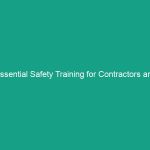Introduction
Good morning team! Today, we are going to talk about an essential aspect of our workplace Environment—stress reduction techniques. As you know, stress can significantly impact our health, safety, and productivity. By understanding and implementing effective stress management strategies, we can create a safer and more supportive workplace for everyone.
Understanding Essential Stress Reduction Techniques
Essential stress reduction techniques are practices designed to lower stress levels and promote mental health in the workplace. These techniques can enhance our focus, improve our mood, and ultimately contribute to a safer working environment. Many employees may think that stress is just a normal part of work life, but high stress levels can lead to serious health issues, decreased performance, and increased risk of accidents.
Key Hazards, Risks, and Safety Considerations
Stress in the workplace can lead to various Hazards and risks, including:
- Increased accidents: High stress may impair decision-making and concentration, leading to workplace accidents.
- Health problems: Chronic stress can result in physical health issues such as heart disease, high blood pressure, and mental health disorders.
- Decreased productivity: Employees under stress may struggle to maintain their usual performance levels, which can affect team goals and deadlines.
Ignoring the importance of stress management can have real-world consequences, including not only reduced employee well-being but also increased absenteeism and turnover rates.
Best Practices, Procedures, & Actionable Advice
Here are some practical stress reduction techniques that you can implement immediately:
1. Mindfulness and Meditation
Taking a few minutes each day to practice mindfulness or meditation can help clear your mind and reduce stress. Consider dedicating 5–10 minutes before or during your break for deep breathing exercises or guided meditation.
2. Physical Activity
Engaging in regular physical activity is a great way to reduce stress. Whether it’s a brisk walk during lunch or a quick stretching session at your desk, movement can elevate your mood and enhance focus.
3. Time Management
Effective time management can alleviate feelings of being overwhelmed. Prioritize your tasks and break larger projects into smaller, manageable steps. Use tools like to-do lists or digital planners to stay organized.
4. Open Communication
Encouraging open lines of communication with your colleagues and supervisors can help address any stressors related to workload or interpersonal relationships. Don’t hesitate to speak up and discuss your concerns.
5. Social Support
Building strong relationships with coworkers can provide a support system during stressful times. Take the time to engage with your colleagues, share your experiences, and foster a collaborative environment.
6. Healthy Work Environment
Creating a comfortable workspace can significantly reduce stress levels. Ensure your work area is organized, well-lit, and ergonomically set up to promote comfort and efficiency.
Regulations, Standards, and Compliance
Understanding and adhering to Workplace Safety regulations is critical in minimizing stress-related risks. Regulations from organizations like OSHA emphasize the importance of maintaining a safe and healthy work environment. By complying with these Standards, you are not only protecting yourself but also your colleagues.
Employee Engagement & Discussion
Let’s take a moment to discuss. Have you experienced any challenges related to stress in your work environment? What strategies have you found helpful in managing stress? Your insights can help us all improve our approaches to Workplace Safety and well-being.
Conclusion & Key Takeaways
In conclusion, implementing essential stress reduction techniques is crucial for fostering a safer workplace environment. By managing stress effectively, we can improve our health, productivity, and overall Safety. Remember, prioritizing your well-being is not just about personal health; it’s about creating a supportive team culture.
Thank you all for your attention and commitment to making our workplace a safer and healthier environment. Let’s continue to support each other and prioritize our mental health together!


